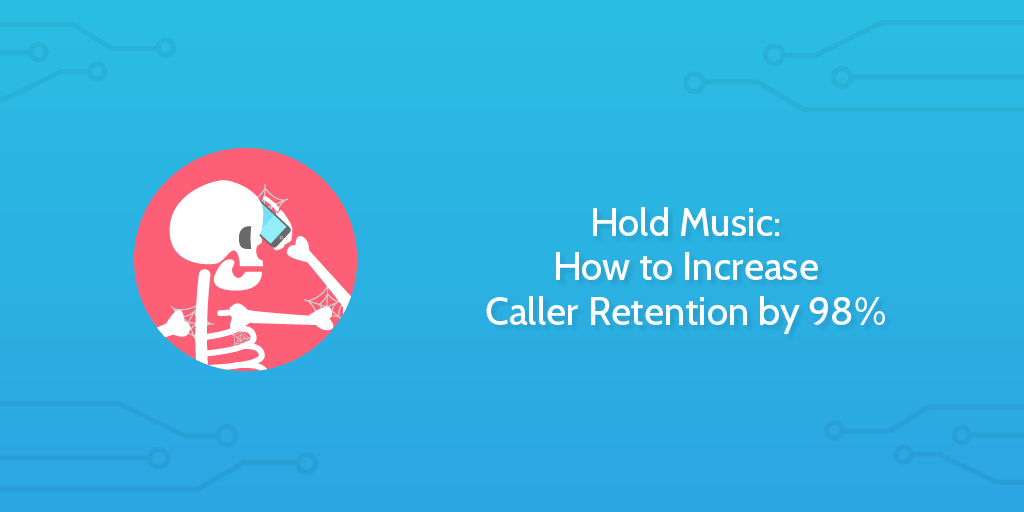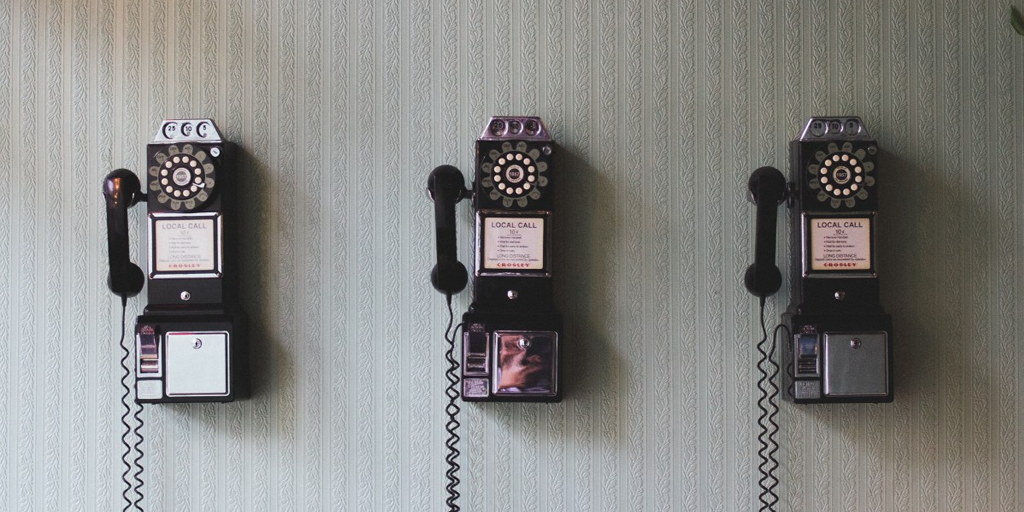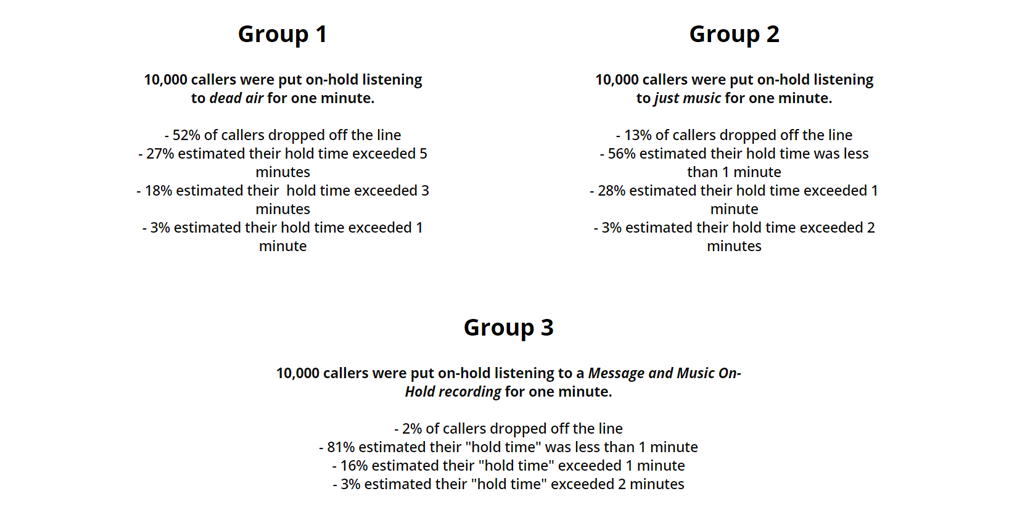
My doctor has the worst phone setup I’ve ever encountered.
Wait times are 30+ minutes, the phones are completely clogged after 10 am, and worst of all is the hold music.
A deafening din of distorted notes which at one point may have resembled “Clocks” by Coldplay. If it wasn’t for my own health, I would happily put the phone down and never ring them again.
However, unless you’re as vital to lives as a doctor, your callers won’t stand for the same treatment.
You need a solid game plan. The best hold music you can get your hands on. You need to entertain and hold their interest while they wait for someone to have the time to deal with their problems, or you can kiss that customer goodbye.
That’s exactly what this post will help you to do.
Read on to find out:
- Why you need the best hold music you can get
- Where hold music started
- How different music affects our emotions
- How to structure your hold system
- Some tips to get the most out of your phone system
The history of hold music

Waiting for a call to be connected was commonplace in the early days of telephone communication. Rather than being a result of busy phone lines and customer support queues, it was an unavoidable part of establishing the correct connection to put you through.
Being put on hold was expected, and even welcomed at first due to the new ability to have the connection in the first place.
Think of it like the early days of the internet. Whereas waiting two minutes to connect at first seemed a small price to pay, with modern technology we get frustrated if a page takes more than 20 seconds to load.
As such, it wasn’t until the late 20th century that the idea to fill the gap with music to reduce caller frustration was born.
In early 1962, a patent was filed for the “Telephone Hold Program System” at the U.S. Patent Office. Invented by Alfred Levy, this is the first official record of such a system.
While no-one is clear on how Levy first thought of the idea, one appealing account is that it happened by complete fluke. Thanks to a loose wire touching a steel girder, a neighboring radio station’s signals were broadcast through his company’s telephone lines.
By the mid-1980s the technique would further develop into adding messages into the mix. Businesses like American Telephone Tapes capitalized on this by creating appealing voices for this specific purpose, leading to the modern hold techniques we’ve come to take for granted.
Why use hold music?

Whether you use the best hold music in the world or a simple repeating jingle, hold music is worth using for one reason.
Customer retention.
USA Business Telephone Today held a study of 30,000 callers. They placed each on hold for one minute, but split the callers into three groups and used different hold techniques on each before measuring the results.
The first group was given silence for the minute on hold. 52% hung up before the minute was up, over half of the remainder (27%) thought they were holding for more than five minutes, and everyone else estimated their hold time as between one and five minutes.
The second was given music to listen to, which greatly reduced churn. Only 13% hung up before the end and 56% believed they had been holding for less than a minute.
The final 10,000 callers was given a mix of music and messages while on hold, further decreasing the drop-off. This time a mere 2% hung up, while 81% believed that they had been on hold for less than a minute.
In other words, if you want to increase your caller retention rate by 98% and make the majority of them believe that they’ve been on hold for less time than they actually have, you should be using a mix of hold music and messages. It’s a vital part in your larger customer success plan.
The only question is, what music and messages should you be using?
How hold music affects us

Almost everyone who’s listened to music knows that it affects your mood in some way. This has been confirmed by many studies over the years, such as one of 2,000 people by Powwownow in which up to 85% of respondents said that they listened to music to get an emotional boost.
Unfortunately, when trying to find the genre to use to create the best hold music, it’s hard to pin down the precise effects.
Most sources agree on the following:
- Jazz is relaxing
- Rap fights depression
- Metal increases your sense of identity
- Country music makes you happy
- Classical relaxes and can even lower crime rates
However, others contend that rap makes you less calm, that classical does (or doesn’t) make you smarter via the “Mozart effect”. Going by that logic, every genre can do everything and nothing, depending on the listener.
So where does that leave our hold music selection?
Well, it depends on what business you’re running, and what your target audience is. It’s a balancing act between using music that’s suitable for the majority of your audience and something that’s still interesting.
One option would be to use Muzak-style recordings – you and I would know it as “elevator music”. While it’s not particularly interesting, these simple instrumental arrangements give callers something to tide them over while being plain enough to be okay for most listeners.
Classical music is another go-to option, although the success of this depends on how lively the track is and what your target audience is like. For example, a business that’s expected to be very formal (eg, an accountancy) would be more suited to classical music than, say, a supermarket.
While the general rules for how music genres affect us are useful to get an idea of the type you can use, there’s so much variation that you’ll need to test out the options yourself.
Still, while there is no set genre for getting the best hold music, there are a few research-backed tips you can put into practice to give yourself the best chance of having your callers stick around.
Hold music tips
Finding nothing but differing opinions on the effects of music genres is disheartening, especially when you’re trying to find the ideal choice to get the best hold music. Thankfully, there are a few tips that do remain constant:
- Allow callers to opt-out of a certain song/genre of music
- Consider using recent hit songs to appeal to most of your callers
- Never assume your selection was correct – test everything
- Use hold messages to promote deals, features, and sell
- Use simple tracks to avoid distortion
- Avoid songs with very loud (or quiet) segments
- Listen to the entire song to test for clipping issues from volume peaks
- Avoid “prosocial” songs
- Reduce hold times as much as possible
General tips
The first way to avoid annoying callers with your hold music is to allow them to opt-out of a certain song, genre, artist, and so on by pressing a button. The only issue is knowing what to replace it with.
Whatever you do, it’s best not to let your callers opt to have silence – I demonstrated above the disastrous effects that has on customer retention.
A great way to compliment this choice system is to have your music selection on shuffle. Even if you only have three or four songs to choose from, this will make sure that those left waiting on hold won’t have to listen to the same tune on repeat.
Also, remember the mention of mixing music with messages from earlier? Well, you don’t have to limit those messages to “thank you for waiting”. Try using various sales messages, marketing material, or even news and weather reports to keep your callers’ interest.
The final strictly non-musical tip is to make sure that your hold queue aligns with your other promotional material. So, if you have a consistent voice (eg, a celebrity or consistent starring figure) in your TV and/or radio advertisements, it’s a good idea to try and get them in to record some of your hold material too.
It’s not vital, but having that consistent voice will do wonders for brand recognition among your callers.
Music selection tips
While I’ve already touched on this, it’s worth stating again that musak, classical music, and recent chart hits are fairly safe options when trying to appeal to a wide array of your callers. The key is to not take these choices for granted and avoid testing what they do in the long run.
Measure the caller retention rates for each of your genre choices, compare them against each other. Combined with user feedback (which you can gather by asking your callers about the music), you should be able to narrow down the best hold music for your business.
However, try to avoid “prosocial” songs.
Songs like “Help” by The Beatles and “Heal The World” by Michael Jackson (called “prosocial” because of lyrics) can be annoying if a caller is ringing up with a help issue.
Think of it this way; the lyrics might be ironic, but you’re nonetheless just reminding them of the problem that’s causing them grief in the first place.
“Call center operators who picked up the phone reported feeling less emotionally exhausted when dealing with customers who heard standard pop music.” – Justin Worland, Why Being Put on Hold Drives You Crazy
Clipping and distortion
Now we reach the technical side of hold music; clipping and distortion. Without getting too in-depth, both of these are issues which make your music sound much worse.
Nobody wants to ring your helpline, only to have warped music layered with static deafen them while they wait. They will, understandably, hang up and be reluctant to call you again.
To stop this from happening, you need to know a little about how each of these problems is caused.
Distortion is usually due to the loss of quality which happens when playing music through your average telephone system. These lines can’t convey as much information as, say, radios can, and so the track loses some of its finesse in translation.
In other words, hold music is around 24 times lower quality than the same music played from a CD.
The way to deal with this is to use music that’s simple enough for the change in quality to be less noticeable. That’s why hold music often uses very few (if only one) instrument – the phone lines can’t replicate an entire orchestra without distorting the sound.
Clipping occurs when the music is too loud for the phone to handle, again, distorting the sound.
This can be easy to miss, as songs tend to vary in volume and often get louder in the final stretch. So, if you only listen to start of the song to check the volume, you need to be aware that it might get louder (or quieter) later on and should be adjusted as such.
Combining the two problems, it’s no surprise that many companies use solo guitar or piano pieces with level volume throughout for their hold music. They’re simple and consistent enough that distortion and clipping aren’t severe issues.
Notable examples
Now that we’ve covered the basic tips of selecting your hold music, let’s provide a few examples to show you what can work in action.
UberConference is up first with their simple and light-hearted take on what hold music should be. It’s also a great example of how you don’t need to get popular artists or songs to make your customers connect with your brand.
“I’m On Hold” was written and performed by UberConference’s (then) creative director and co-founder, Alex Cornell. He knew about the problems with putting music through phone lines, and so chose to record a song with only high-frequency instruments and a simple arrangement.
This let Alex record the song he wanted to make while working with the limitations of hold music. Rather than fighting it and having the track distort, he recorded a country song which only needed acoustic guitar and light drums.
Another great example is one of Shopify’s hold music tracks – a cover of a song called “Yearning of the Wind” from Chrono Trigger.
While this ticks all of the boxes you would want from a regular hold music track (it’s simple, has little volume variation, and has the same widespread appeal as classical music), it also has a hidden benefit. Being a cover from a classic RPG gives it an extra appeal for those in the know.
Both of these examples show how a little thought and creativity can inject personality into your hold music, and even bring extra publicity for your company.
Hold music is no substitute for low queue times
So there you have it.
By keeping your hold music to a selection of simple songs which don’t vary too much in volume, you can vastly increase the number of callers who stick around and speak to your team.
Still, even the best hold music can’t help you if your queue times are too long.
The key is to decrease your queue time and use the right hold music (mixed with promotional and helpful messages). That way your team will have enough time to deal with everyone who calls but avoids the problem of annoying your callers with either an inefficient system or inappropriate music.
Do you have any stories to tell from being put on hold? I’d love to hear them in the comments!







Ben Mulholland
Ben Mulholland is an Editor at Process Street, and winds down with a casual article or two on Mulholland Writing. Find him on Twitter here.